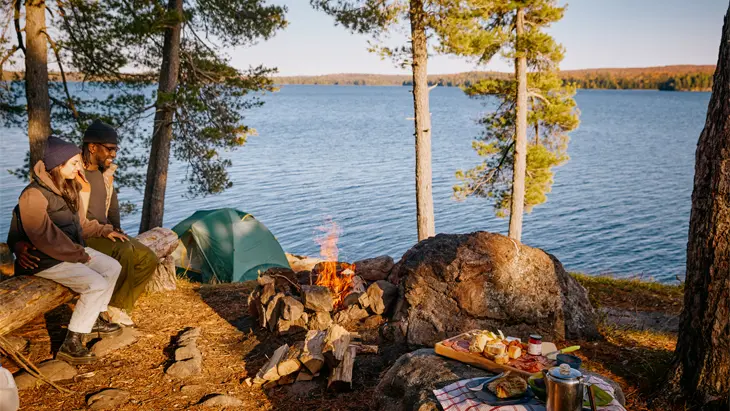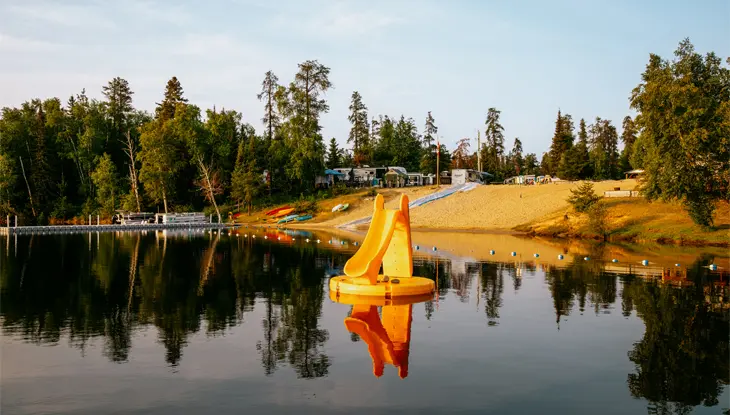How to prepare for a camping trip in Ontario

Opeongo Lake | Algonquin Provinvial Park
Ontario offers various camping experiences. Once you’ve decided on a type, you’ll need to start packing. A camping checklist will help you organize and pack for your trip.
In addition, there are essential things to know before you set out, such as weather conditions, potential fire bans, safety tips and camping etiquette.
Choose your camping style
The first decision is choosing the type of shelter that suits you. Consider how much "roughing it" is right for you and your group. Select from:
Tent camping sites in Ontario are available in Ontario Provincial Parks, national parks, conservation areas and private campgrounds.
Front-country tent camping is the best option for beginners and families. If you’re camping in a provincial or national park, front-country camping sites are accessible by vehicle. This is also called "car camping" or using "car campgrounds."
Facilities differ between parks; however, most car-access campgrounds feature comfort stations with flush toilets and showers, drinking water, picnic shelters and playgrounds.
Some sites will also provide electrical hook-ups.
Backcountry sites are located deeper into the wilderness. They are accessible by hiking or paddling in and are best suited for experienced campers.
For beginners, the best time to go tent camping in Ontario is from late May to early October. You’ll enjoy mild to warm temperatures, a lower chance of rain and outdoor activities such as swimming, hiking and paddling.
Roofed accommodations
Some provincial and national parks offer roofed accommodations like cabins, cottages and yurts. These provide campers with the opportunity to be surrounded by the beauty of Ontario wilderness without the need to invest in tents and other camping gear.
Park cabins are typically small, rustic wooden shelters. Yurts are cozy dwellings made with a circular wood frame covered with canvas or felt. Both accommodations usually have basic furniture and amenities like a barbecue and fire pit.
Recreational Vehicle (RV) camping
RV camping involves driving your RV to a campground or RV park.
Ontario Parks and private campgrounds offer RV camping sites. This is a great way to combine a stay in the great outdoors with the additional flexibility that wheels provide.
GoRVing Canada is an excellent resource for all things RV, with information on everything from RV rentals to a listing of private RV parks and resorts in Ontario.
Glamping
Glamping, short for glamorous camping, is like tent camping but with all the comforts of a boutique hotel. Rather than sleeping in a tent pegged to the ground, glamping sites offer larger canvas tents atop a wood floor. The interiors often include a luxury bedroom set, with plush bedding and many of the amenities one might find in a hotel room.
Glamping sites in Ontario are privately owned, so you’ll need to book directly with the operator.
How to book a campsite
If you plan to go tent or RV camping in one of Ontario’s provincial parks, national parks or conservation areas, you’ll need to make a reservation in advance. Book as early as possible to avoid disappointment, as summer campsites tend to fill quickly.
Roofed accommodations are even more limited and often require a minimum stay of two or more nights.
Ontario Parks
Ontario Parks campsite reservations can be made online or over the phone. Use the Park Locator to find the best park experience for you.
Ontario Parks has reduced the maximum length of stay at select parks during peak seasons to help connect more campers with campground sites and experiences.
Find more tips on making your reservation.
Parks Canada
Camping reservations for national parks in Ontario can be made online at Parks Canada.
Private campgrounds and RV parks
To book a private camping or RV site, visit Camping in Ontario, which features over 350 privately owned campgrounds.
Learn more about private campgrounds and RV parks in Ontario.
What to pack for a camping trip
Figuring out your camping packing list can be daunting. What you need will vary based on your planned activities, time of year and trip length.
Here’s a sample checklist of basic camping essentials for beginners, plus considerations of other things to bring on a camping trip.
Tent and other essentials
The first thing you’ll need is a good tent that’s large enough for everyone in your group to sleep comfortably, plus extra room for bags, shoes and gear.
If your tent is new, practice putting it up and taking it down before setting out. Tent sets usually come with tent pegs. You may want to include a mallet to secure the pegs with. And even a small broom and dustpan to clear out sand and dirt from your tent.
Next, each camper should have a sleeping bag, pillow and sleeping pad or air mattress. Ensure the sleeping bags are rated for the temperatures you expect during your trip.
Additional gear you’ll want to consider include:
- A groundsheet for under your tent. It should be slightly smaller than the outside dimensions of your tent to avoid water pooling.
- An indoor/outdoor carpet or a mat for outside your tent.
- One or more durable, waterproof tarps with rope to cover your outside cooking and eating area. Some campers pack a dining tent in addition to their sleeping tent, but an extra tarp is always a good idea.
- Extra rope and clothespins to dry clothes and towels.
- An axe or hatchet for splitting wood.
- Flashlights, headlamps, battery-powered lanterns, extra batteries, candles and matches or a lighter.
- In addition to a sturdy backpack for your gear, you’ll want a small backpack for hiking excursions.
- A solar-powered or electric phone charger.
- If you're planning on hiking and paddling, bring a map and compass. Cell service is often unavailable in remote locations, so a GPS unit is a wise idea.
- Folding table and chairs if your campsite does not have picnic tables.
- Extension cords if your campsite has electricity.
Cooking and other outdoor kitchen basics
Cooking and dining outdoors is great fun, but only when prepared. Your outdoor kitchen should include:
- A fuel-powered stove top with extra fuel.
- Pots, frying pan, oven mitts and potholder.
- Plastic or steel washable plates, bowls, cups, mugs and eating and cooking utensils, including a set of sharp knives.
- Plastic containers to store your food and to keep your perishable items cool, bring a cooler with multiple ice packs.
- Cutting board, can opener, corkscrew and a kettle (electric, if you have electricity available, or a stovetop kettle)
- A compactable plastic basin large enough to wash dishes, biodegradable dish soap, scrub pad and drying towels.
- Paper towels, aluminum foil, plastic wrap, garbage bags, duct tape and a wipeable tablecloth if your site has a picnic table.
- A personal water bottle for each camper.
First aid kit and personal items
Be prepared for all the little scrapes, spills and mishaps that will inevitably happen in the great outdoors. And don’t forget to bring personal necessities and entertainment for the kids. Stock up with:
- A first aid kit designed for camping with lots of band-aids.
- Sunscreen and sunburn lotion, burn ointment, insect repellent with DEET, bug spray and afterbite lotion.
- Aspirin or ibuprofen, antihistamine medication, a thermometer, personal prescriptions and EpiPen.
- A pocketknife, tweezers and sewing kit.
- Hand sanitizer, wipes and toilet paper.
- Eco-friendly, biodegradable soap and a portable shower or shower bag if your campsite has no shower access.
- Hats, sunglasses and flip-flops or plastic shoes for showers.
- Games, books and camera equipment.
Know before you go
Important things to know before you set out on a camping trip in Ontario include the following.
Drinking water
Not all parks provide access to clean drinking water. Check in advance to see if you need to bring your own drinking water or a water purifier kit.
Campfires and firewood
During the summer, outdoor fire restrictions or full fire bans are issued in areas at risk for forest fires. Always check for any restrictions in the locations you plan to visit.
It is not permitted to bring campfire wood into Canada from the U.S. National and provincial parks in Ontario require firewood to be purchased onsite or nearby to prevent the spread of forest pests.
Camping supplies
Many campgrounds have park stores, but their stock of everyday items is limited. If you’re camping in an Ontario park, check if there are general or grocery stores nearby just in case you run out of something important. Like marshmallows or hotdogs!
Weather
Check the weather forecast before you leave so you can be fully prepared for rain, thunderstorms, heatwaves and cold snaps. Plan ahead to see what else there is to do for family outings, especially on rainy days.
Fishing licence
A licence is required to fish in Ontario. Exemptions include designated licence free fishing days for Canadian residents four times a year, as well as anyone under 18 or older than 65 years of age.
If you plan on fishing during your camping trip, get your fishing licence online or in-person at a Service Ontario location or licence issuer.
Canoe and kayak rentals
Enjoy outdoor activities like canoeing and kayaking. Find a list of outfitters and equipment rentals in popular Ontario parks.
Safety tips and campsite etiquette
Finally, here are a few safety tips and camping reminders.
- Ontario’s wilderness is home to diverse wildlife, some of which will be attracted to the scent of human food and activity. Keep your campsite clean of anything that will attract bears or other critters. Learn how to bear-proof your campsite.
- Outside of meals, all food should be securely stored in containers and coolers. You may want to store them in your car. Backcountry campers will need to learn how to hang your supplies away from your campsite.
- Remove trash from your camp, either in the bins provided at the site, in your car or safely hung if you are in the backcountry.
- Dispose of grey water responsibly if you are RVing.
- Keep your pets on a leash at all times, except when visiting off-leash dog zones.
- When hiking, always stay on the designated trails. And bring insect repellent, sunscreen, water, snacks and a small first aid kit. Wear closed-toe shoes, long sleeves and long pants to avoid contact with poison ivy and to limit bug bites.
- Sound carries in the outdoors, so a respectful volume in the early morning and evening will make you a great camping neighbour.
- Always abide by the Leave No Trace principles, leaving as small a footprint on nature as possible.
When properly prepared, camping in Ontario could easily become one of the best memories you can make this season with your family and friends.
Happy camping!
Related content
Last updated: September 2, 2025


